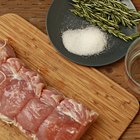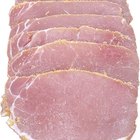
The only safe way to can pork tenderloin is by using the pressure canning method. Meat is an extremely low acid food, so more heat is required in the canning process to kill any bacteria. The sealed lid on a pressure canner allows heat and pressure to build up inside the canner, which successfully kills any bacteria in the meat. Canning pork tenderloin when you are able to purchase it on sale can prove to be a huge savings to your grocery budget later on down the road, while still allowing you to enjoy an expensive cut of meat.
Choose high quality tenderloin. Rinse the pork and then chill in the refrigerator for at least four hours before beginning the canning process.
Sterilize the half-pint jars by washing them in the dishwasher on the sterilize cycle. If you don’t have a dishwasher sterilize them by placing the seals and lids in boiling water for five minutes and the jars in boiling water for ten minutes.
Cut the meat into cubes or slice it into small enough pieces that it fits easily into a half-pint jar if you want to cold pack the meat, which means canning it completely uncooked. If you want to hot pack, or partially cook, the meat before canning, roast, stew or brown the meat until rare by stewing, roasting or browning in a pan. Either method works fine; it is simply a matter of personal preference.
Pack the jars with the meat, leaving one inch of headspace. Boil water, broth or tomato juice and then pour the boiling liquid over the meat leaving one inch of headspace. Place the seals and the rings on the jars.
Place the jars on the racks in the pressure canner. Follow the directions that came with the pressure canner on setting the gauge, adding the water and venting during the canning process. Each pressure canner is slightly different. Follow the manufacturer’s directions exactly, to prevent the canned meat from spoiling and to avoid getting burned. Process the meat in the pressure canner for 75 minutes.
Remove the cans with a pair of canning tongs, sit them on a rack or a towel to allow the air to circulate and let them cool completely. Do not allow cans to touch while they are cooling.
Once cool check the small dot in the center of the lid to determine that it has sealed properly, if it has, it will be slightly depressed. If any of the cans did not seal, either repeat the canning process after repacking in newly sterilized jars, or place those that did not seal properly in refrigerator and eat within three to four days.
Related Articles

How to Can Beef Meat With a Pressure ...

How to Can Venison Meat

How to Can Homemade Vegetable Beef Soup

How to Can Jelly Using a Pressure Canner

How to Marinate Meat With a FoodSaver

If Meat Is Frozen, How Long Does It ...

How to Store Leftover Roast Pork

How to Smoke Tuna

How to Can Salmon Fish

Can You Freeze Canned Goods?

How to Can Fish in a Pressure Canner

How to Pressure Can Trout

How to Brine a Smoked Beef Brisket

How to Brine Pork Roast

How to Defrost a Frozen Beef Roast in ...

How to Cook Pan Fried Deer Tenderloin

How to Process & Seal Hot Sauce Bottles

How to Freeze Pot Roasts

How to Cook a Boneless Sirloin Pork ...

How Do I Tell If Pork Has Turned Bad?
References
Writer Bio
Annabelle Lee has been working in the journalism field since 1990. She was a teacher and yearbook adviser for four years and holds two associate degrees from her local community college where she currently teaches computer classes. Lee also writes for a local newspaper and was a proofreader for McGraw-Hill.
Photo Credits
Jupiterimages/Brand X Pictures/Getty Images